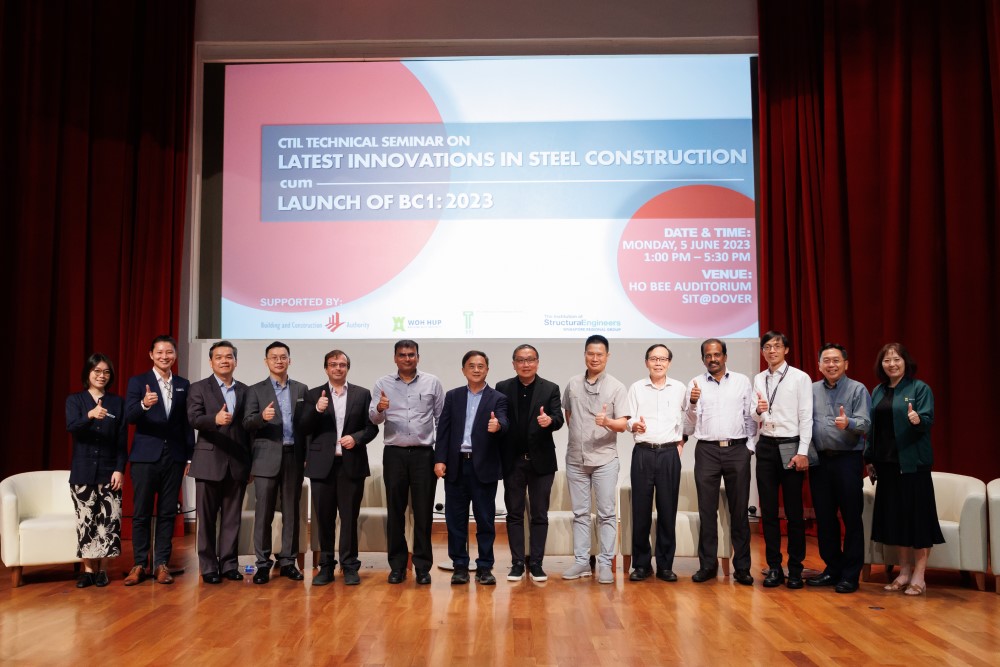
Latest Innovations in Steel Construction and the Launch of BC1:2023

5 June 2023 - The Construction Technology Innovation Laboratory (CTIL) held a half-day technical seminar at SIT’s Ho Bee Auditorium on 5 June 2023 to witness the launch of the third edition of BC1:2023 – a design guide for the use of alternative structural steel. Er. Thanabal Kaliannan, Commission of Building Control, Building and Construction Authority (BCA), was the Guest-of-Honour at the seminar, which was supported by IStructE Singapore Regional Group. Targeted at built environment professionals, the seminar saw leading industry speakers and academic researchers share steel construction challenges and innovative use of alternative structural steels to a full house of over 240 Professional Engineers.
Here are some of the presentation highlights.
In the CTIL technical seminar, Er. Prof Chiew Sing-Ping from the Engineering cluster at SIT presented the latest update in BC1:2023, highlighting two key changes: the accreditation of certification bodies and the inclusion of Korean steel standards. These changes will provide a wider variety of alternative structural steels for the industry to be more sustainable and less restrained by the material supply shortage.
Comprehensive studies were conducted to investigate foreign national standards and to ensure they were comparable or even superior to BS EN standards. The result of the studies showed that the steel sections from foreign national standards do not significantly affect the design capacity. Prof Chiew further introduced the Singapore Accreditation Council (SAC) Accredited Certification Scheme to CT24:2021 for the requirement of independent accreditation on structural steel quality from the supplier. He concluded his presentation by encouraging the industry players to broaden their material supply with the consideration of alternative structural steels.
Next, Er. Kam Mun Wai, Senior Executive Director of Meinhardt (Singapore) Private Limited, took the audience through seven projects, demonstrating the benefits of using structural steel to overcome construction challenges due to a project’s complex layouts. He highlighted the importance of construction stage design in controlling the lateral movement to mandated limits. He emphasised that structural steel application facilitates prefabrication off-site and improves productivity through better quality control and reduced wastage.
Following Er. Kam’s presentation, Mr Guna, Senior Project Director at Woh Hup, presented on the construction challenges encountered during the development of the Punggol Digital District (PDD). These challenges were mainly attributed to material supply disruptions, labour shortages, and the COVID-19 pandemic. PDD is a remarkable SGD$1 billion mixed-use development spanning across a 50-hectare site, comprising three creative cluster parcels known as CC1, CC2, and CC3. The project incorporates eight towers and integrated basements that extend as deep as 30 meters. Mr Guna demonstrated the steel construction difficulty for the Tower 7 transfer truss, where the off-site fabrication and on-site assembly had been closely monitored to ensure accuracy and that it is within the constriction tolerance.
Dr Ng from TTJ Design and Engineering Private Limited presented the extensive research conducted on grade S690 structural steel and its practical application. He elaborated on how the higher strength steel can provide weight saving towards the construction and illustrated the practical application of S690 on king-post fabrication and installation, where approximately 41.3% weight saving can be achieved at the given design capacity. The structural steel is also within the code requirement such as EN1993 Part 1-12 and EN10025-6.
Dr Zhao Ming Shan, Assistant Professor from the Engineering cluster at SIT explained how the construction industry can be more sustainable by tackling embodied carbon, reducing virgin materials input, and improving construction productivity. He presented his finding on the usage of high-performance pre-engineered steel concrete composite beams and their embodied carbon reduction in comparison to conventional RC construction. He emphasised the potential of reusability of structural steel once the buildings were decommissioned.
The seminar’s concluding speaker was Dr Paolo, a blast impact analysis specialist from SIT. Dr Paolo focused on the design of blast door systems and presented his research on improving design efficiency for complex loading scenarios. During his presentation, he showcased the impact loadings resulting from blasts and shared the results of his comprehensive finite element analysis (FEA) study, which aimed to simulate the effects of load-time impact. His findings showed that Single Degree of Freedom (SDOF) analysis can simplify the complicated FEA simulation and how the SDOF design can provide practical application on the blast door system.
